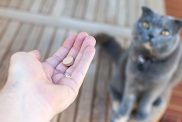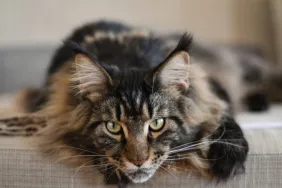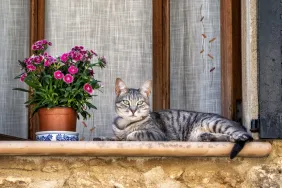Obesity is becoming an increasingly common problem for our cats.
Currently, in the United States, veterinarians estimate that about 60 percent of the feline patients seen are either overweight or obese. Even more alarming is the fact that many cat parents fail to recognize that their cats are overweight.
October 9th is National Pet Obesity Awareness Day, but obesity is a problem for our pets all year long. It’s important to learn the causes, the ways to spot the problem, and how to fight obesity to keep our cats healthy.
Here’s what you should know about feline obesity and what to do if your cat is overweight.
How To Tell If Your Cat Is Overweight
Cats who are not overweight have an ideal body condition. These cats’ ribs can be felt without a pad of fat between the skin and ribcage, and they have a waist when viewed from above.
If you cannot feel your cat’s ribs or see your cat’s waist, your cat is likely overweight or obese.
If in doubt, your veterinarian can help you determine whether your cat is at the proper weight.
Causes Of Cat Obesity & Health Risks

Too many calories and not enough exercise are the most common causes of obesity for your cat; although, other factors such as genetics may play a role as well.
Sometimes cats have hormone conditions that contribute to obesity. Your vet can test for these conditions and advise you on dietary changes to maintain health and an appropriate weight.
Most of the time, however, feline obesity comes down to overfeeding and a lack of exercise.
Being overweight or obese puts your cat at risk for serious diseases, such as diabetes, arthritis, liver disease, skin disease, lower urinary tract disease, and more. Overweight cats are also more likely to experience surgical or anesthetic complications and heat exposure.
How Can You Help Your Cat Lose Weight?
Before you begin any weight reduction program, have your vet perform a physical examination for your cat. Once your vet has determined that your cat is fit enough to start a weight reduction program, there are several things you can do to help.
Slowly decrease your cat’s caloric intake over time. Rapid weight loss is as unhealthy for your cat as it would be for you. Cut your cat’s calorie intake by no more than ten percent at a time.
Consider switching your cat to a diet that’s less energy dense by choosing food that’s lower in fat, higher in fiber, and higher in moisture content. Feed your cat controlled, measured meals daily rather allowing them to forage and eat as much they like.
Make your cat work for their food.
- Use food puzzles to increase your cat’s activity and mental stimulation.
- Scatter your cat’s food in different places throughout your home rather than feeding in one location.
- Provide barriers your cat must overcome to reach their food by placing it in an elevated location or behind a fence or baby gate.
Add toys and other forms of environmental enrichment such as scratching posts and perches to encourage your cat to exercise more.
Set aside time during your day to have some interactive play with your cat using toys they can chase or stalk. Discover what type of toys your cat prefers and take advantage. Some cats prefer toys with feathers; others prefer mouse-like toys. Some cats will chase laser pointers, also.
A combination of decreased calories and increased exercise will help your cat lose the pounds and regain their perfect body condition.
How do you make sure your cat stays at a healthy weight? What tips do you have for other cat parents? Let us know in the comments below!









